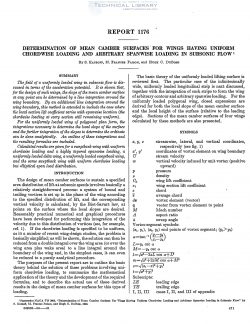naca-report-1176
- Version
- 165 Downloads
- 1.31 MB File Size
- 1 File Count
- November 2, 2016 Create Date
- November 2, 2016 Last Updated
National Advisory Committee for Aeronautics, Report - Determination of Mean Camber Surfaces for Wings Having Uniform Chordwise Loading and Arbitrary Spanwise Loading in Subsonic Flow

The design of mean camber surfaces to sustain a specified
area distribution of lift at subsonic speeds involves basically a
relatively straightforward process: a system of bound and
trailing vortices is set up in the plane of the wing according
to the specified distribution of lift, and the corresponding
vertical velocity is calculated, by the Biot—Savart law, at
points on the surface Where the local slopes are desired.
Reasonably practical numerical and graphical procedures
have been developed for performing this integration of the
velocity due to this distribution of vortices (see, for example,
ref. 1). If the chordwise loading is specified to be uniform,
as in a number of recent wing-design studies, the problem is
basically simplified; as will be shown, the solution can then be
reduced from a double integral over the wing area (or over the
wing area plus wake area) to a line integral around the
boundary of the wing and, in the simplest cases, it can even
be reduced to a purely analytical procedure.
The purposes of the present report are to outline the basic
theory behind the solution of these problems involving uni—
form chordwise loading, to summarize the mathematical
application of the theory and the development of the required
formulas, and to describe the actual use of these derived
results in the design of mean camber surfaces for this type of
loading.
The basic theory of the uniformly loaded lifting surface is
reviewed first. The particular case of the infinitesimally
wide, uniformly loaded longitudinal strip is next discussed,
together with the integration of such strips to form the wing
of arbitrary contour and arbitrary spanwise loading. For the
uniformly loaded polygonal wing, closed expressions are
derived for both the local slope of the mean camber surface
and the local height of the surface (relative to the leading
edge). Sections of the mean camber surfaces of four wings
calculated by these methods are also presented.
| File | Action |
|---|---|
| naca-report-1176 Determination of Mean Camber Surfaces for Wings Having Uniform Chordwise Loading and Arbitrary Spanwise Loading in Subsonic Flow.pdf | Download |

Comment On This Post